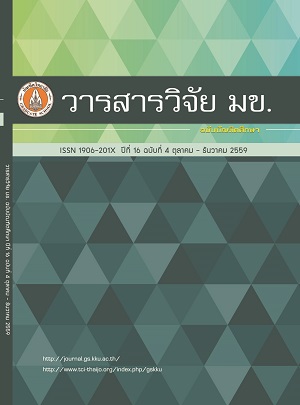ผลของการให้กรดทาเนซามิคต่อกระบวนการสลายลิ่มเลือดและการเสียเลือดในสุนัข ที่ได้รับการผ่าตัดทำหมันด้วยวิธีตัดรังไข่และมดลูก (Effect of Tranexamic acid on Fibrinolysis and Bleeding in Dogs undergoing Ovariohysterectomy)
Keywords:
กรดทาเนซามิค (Tranexamic), กระบวนการสลายลิ่มเลือด (Acid fibrinolysis), การเสียเลือดในสุนัข (Bleeding in dogs)Abstract
การวิจัยครั้งนี้มีวัตถุประสงค์ เพื่อศึกษาผลของการให้กรดทาเนซามิค (tranexamic acid, TXA) ต่อเปอร์เซ็นต์เม็ดเลือดแดงอัดแน่น ปริมาณโปรตีนทั้งหมด ไฟบริโนเจน ดี-ไดเมอร์ และการเสียเลือดในสุนัขที่ผ่าตัดทำหมันด้วยวิธีตัดรังไข่และมดลูก การทดลองนี้ใช้สุนัขเพศเมียสุขภาพดี 17 ตัว แบ่งเป็น 2 กลุ่ม กลุ่มแรก เป็นกลุ่มควบคุมได้รับน้ำเกลือ (สุนัข 8 ตัว) กลุ่มที่สองเป็นกลุ่มทดลองได้รับ TXA ขนาด 15 มิลลิกรัม/กิโลกรัม (สุนัข 9 ตัว) ผลการศึกษา พบว่า ค่าเฉลี่ย ดี-ไดเมอร์ หลังการผ่าตัดของกลุ่มทดลองต่ำกว่ากลุ่มควบคุมอย่างมีนัยสำคัญทางสถิติ (p<0.05) ส่วนค่า เปอร์เซ็นต์เม็ดเลือดแดงอัดแน่น ปริมาณโปรตีนทั้งหมด ไฟบริโนเจน และการเสียเลือดของสุนัขทั้ง 2 กลุ่มไม่แตกต่างกันทางสถิติ (p>0.05) การศึกษานี้แสดงให้เห็นว่า การให้ TXA ขนาด 15 มิลลิกรัม/กิโลกรัม ฉีดเข้าทางหลอดเลือดดำช้าๆ ก่อนการผ่าตัดทันทีหลังสุนัขสลบ มีผลช่วยลดการสลายลิ่มเลือดในสุนัขที่ผ่าตัดทำหมันด้วยวิธีตัดรังไข่และมดลูก
The research aimed to assess the effects of Tranexamic Acid (TXA) on the percentage of packed cell volume, quantities of total protein, fibrinogen, D-dimer and bleeding in dogs sterilized by Ovariohysterectomy (OVH). The 17 healthy female dogs were sterilized by Ovariohysterectomy technique for the experimental research. The dogs were divided into two groups: control and treatment groups before the sterilization. Saline solution (NSS) was injected to eight dogs of the control group while 15 milligram/kilogram of TXA was injected to nine dogs of the experimental group. The research showed that the average D-dimer value of the dogs of the experimental group after the sterilization was lower than that of the control group at the .05 level of the statistical significance. Whereas, the percentage of PCV, quantities of total protein, fibrinogen, and bleeding in both groups of the sterilized dogs were not different at the .05 level of the statistical significance. The study indicates that the 15 milligrams/kilogram of TXA injected through cephalic vein decreases Fibrinolysis of the sterilized dogs with the OVH.


